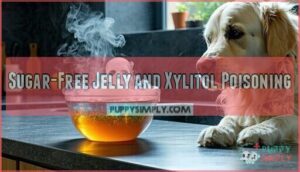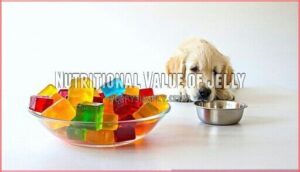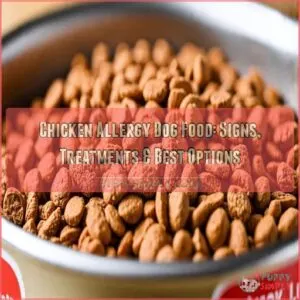This site is supported by our readers. We may earn a commission, at no cost to you, if you purchase through links.

Most jellies contain ingredients that can seriously harm dogs. Grape jelly is particularly dangerous because grapes cause kidney damage in dogs, even in small amounts.
Sugar-free jellies are equally risky since they contain xylitol, an artificial sweetener that triggers life-threatening drops in blood sugar and liver problems.
Regular jellies packed with sugar aren’t safe either – they contribute to obesity, dental issues, and diabetes.
Even fruit jellies made from "safe" fruits like strawberries carry risks from added sugars and preservatives. Your dog’s digestive system isn’t designed to handle these concentrated sweets, and the consequences can range from upset stomachs to emergency vet visits.
Table Of Contents
- Key Takeaways
- Jelly Toxicity in Dogs
- Can Dogs Eat Jelly
- Health Risks of Jelly
- Safe Alternatives to Jelly
- Types of Jelly and Their Risks
- Preventing Jelly Ingestion
- What to Do if Dog Eats Jelly
- Nutritional Value of Jelly
- Risks of Regular Jelly Consumption
- Keeping Dogs Safe From Jelly
- Frequently Asked Questions (FAQs)
- What kind of jelly can dogs eat?
- Can dogs eat sugar-free jelly?
- Can dogs eat peanut butter and jelly?
- Can dogs eat petroleum jelly?
- Can dogs eat jam?
- Can dogs eat different types of jelly?
- Can dogs eat jelly made from safe fruits?
- How much jelly is dangerous for dogs?
- What about gelatin supplements for dogs?
- Are jelly beans safe for dogs?
- Conclusion
Key Takeaways
- Never give your dog jelly of any type – all varieties contain dangerous ingredients like xylitol (in sugar-free versions) or excessive sugar that can cause serious health problems or death
- Grape jelly is especially deadly – even tiny amounts can trigger kidney failure in dogs, and there’s no safe serving size when it comes to grape-containing products
- Sugar-free jellies contain xylitol, which is toxic – this artificial sweetener causes rapid blood sugar drops, seizures, and liver damage within minutes of consumption
- Offer fresh fruits instead – skip all jellies and give your dog safe alternatives like apple slices, blueberries, or plain banana pieces for a healthy treat
Jelly Toxicity in Dogs
Jelly poses serious toxic risks to your dog’s health through dangerous ingredients like xylitol and grape juice. Even small amounts can cause life-threatening poisoning that requires immediate veterinary attention.
Xylitol and Grape Poisoning
Xylitol toxicity strikes fast when your dog eats sugar-free jelly.
Minutes matter when sugar-free jelly hits your dog’s system—xylitol poisoning moves lightning-fast.
This sweetener causes dangerous blood sugar drops within minutes, leading to seizures and liver damage.
Even tiny amounts prove deadly.
Grape jelly poses equal danger – grapes trigger kidney failure in dogs.
One grape can be fatal, and both xylitol and grape dangers make any jelly a serious threat to your pet’s life, due to the potential for liver damage.
Artificial Sweeteners and Preservatives
Beyond xylitol and grapes, commercial jellies contain numerous artificial sweeteners and preservatives that threaten your dog’s health.
Up to 65% of processed jellies include synthetic additives not found in natural fruits.
Common toxic ingredients include:
- BHA and BHT preservatives – linked to cancer risks in dogs
- Aspartame and sucralose – can alter gut bacteria and cause neurological issues
- Sodium benzoate – converts to carcinogenic benzene under acidic conditions
- Sulfite preservatives – trigger allergic reactions and respiratory distress.
These artificial sweeteners and preservatives create a cocktail of potential toxicity, making even "regular" jelly dangerous for canine consumption.
Symptoms of Jelly Poisoning
Recognizing pet poisoning symptoms can save your dog’s life when toxic ingredients strike fast.
Watch for these warning signs that demand immediate veterinary attention.
| Immediate Symptoms | Severe Symptoms |
|---|---|
| Vomiting | Seizures |
| Diarrhea | Kidney failure |
| Lethargy | Liver damage |
| Loss of appetite | Breathing problems |
| Abdominal pain | Collapse |
Xylitol poisoning shows symptoms within 30 minutes, while grape toxicity may take hours to appear.
Can Dogs Eat Jelly
While jelly might seem like a harmless treat, dogs shouldn’t eat jelly under any circumstances. The answer to "is jelly safe for dogs" is a definitive no.
Most commercial jellies contain dangerous jelly ingredients that pose serious jelly risks dogs face daily. Sugar-free varieties contain xylitol, an artificial sweetener that’s toxic to dogs even in tiny amounts.
Regular jelly packs excessive sugar that can lead to obesity and dental problems. Grape jellies are particularly deadly since grapes cause kidney failure in dogs.
Even jellies made with safe gelatin aren’t recommended due to added sugars and preservatives. Gelatin, however, can offer joint health benefits for dogs in moderation.
Label reading becomes essential when checking any products around your dog. Look for xylitol, artificial sweeteners, or grape content.
Instead of risking your dog’s health, explore jelly alternatives like fresh fruits or homemade recipes using plain, unflavored gelatin with dog-safe ingredients. Commercial dog treats formulated specifically for canines provide safer options.
Your dog’s wellbeing trumps any momentary pleasure from sharing human food.
Health Risks of Jelly
Jelly poses serious health threats to your dog that can range from uncomfortable digestive upset to life-threatening organ failure.
Understanding these specific risks will help you recognize why even small amounts of jelly should never be part of your pet’s diet, as it can lead to severe consequences, including life-threatening organ failure.
Hypoglycemia and Liver Failure
The silent threat of xylitol dogs face can’t be overstated.
This artificial sweetener triggers a dangerous insulin response within minutes, causing severe hypoglycemia and potentially fatal liver damage.
Immediate treatment is vital when seizure risks escalate.
Critical xylitol dangers include:
- Rapid hypoglycemia – blood sugar drops within 30 minutes
- Progressive liver damage – enzyme levels spike dangerously
- Life-threatening seizures – neurological symptoms worsen quickly
Kidney Damage and Failure
Certain jelly ingredients can trigger severe kidney failure in your dog.
Grape toxicity from grape jelly contains tartaric acid that damages kidney cells, potentially causing irreversible renal failure.
Even tiny amounts prove fatal – some dogs develop organ failure within 72 hours.
Xylitol dogs face additional kidney stress alongside liver damage.
Toxic jelly dogs require immediate veterinary intervention to prevent death from complete kidney shutdown, which can lead to irreversible renal failure.
Cancer and Other Chronic Diseases
Long-term sugar consumption from jelly creates serious health risks beyond immediate poisoning.
Artificial sweeteners dogs consume regularly increase cancer development chances in laboratory studies.
Chronic sugar risks lead to obesity risks that strain your dog’s entire system.
Diabetes impact becomes inevitable when dogs eat sugary treats consistently.
Dental deterioration accelerates rapidly, causing painful infections.
Your dog’s diet shouldn’t include these hidden dangers lurking in seemingly innocent treats.
A better approach involves focusing on high-fat, low-carb options.
Safe Alternatives to Jelly
You don’t have to eliminate treats from your dog’s life just because jelly is off-limits.
Plenty of safe alternatives can satisfy your pup’s sweet tooth without putting their health at risk.
Fresh Fruits and Vegetables
Smart pet parents know that nature offers the best alternatives to dangerous jelly.
Safe fruits like bananas, apples, and blueberries provide vitamins without toxic risks. Avoid toxic veggies like onions and garlic.
Keep serving sizes small—a few pieces prevent upset stomachs. Remove seeds and cores during preparation methods.
Dog safe fruits offer healthy alternatives. Watch for allergy concerns when introducing new foods to dogs.
Homemade Dog Treats
Making homemade dog treats gives you complete control over what your furry friend consumes. You’ll know every ingredient that goes into their snacks, ensuring nothing harmful sneaks in.
You can even find specialty baking supplies for your canine creations.
Consider these simple homemade jelly alternatives:
- Frozen banana and peanut butter puree in ice cube trays
- Plain gelatin mixed with dog-safe fruit puree
- Pumpkin and oat flour baked into chewy squares
- Sweet potato slices dehydrated until chewy
Focus on nutritional balance when creating dog treat recipes. Store homemade treats in airtight containers for freshness.
Commercial Dog Treats
Store-bought dog treats offer convenience and safety when you choose wisely. Look for brands that list real meat as the first ingredient and avoid artificial preservatives. Always check treat ingredients for xylitol, which remains deadly even in commercial products designed for pets.
One can also consider homemade dog treat recipes for better control over ingredients.
| Safe Commercial Options | Red Flag Ingredients |
|---|---|
| Blue Buffalo Life Protection | Xylitol or artificial sweeteners |
| Zuke’s Mini Naturals | BHA/BHT preservatives |
| Wellness CORE Pure Rewards | Grape or raisin extracts |
Quality commercial dog treats provide better nutritional value than jelly while addressing allergy concerns through limited ingredient formulas. These safe brands prioritize dog nutrition and pet health over flashy marketing.
Types of Jelly and Their Risks
Different types of jelly pose varying levels of danger to your dog, with some being immediately life-threatening while others cause slower health problems.
You’ll need to understand which jellies are most toxic so you can protect your pet from accidental poisoning.
Grape Jelly and Kidney Failure
Grape jelly poses extreme danger to your dog’s kidneys.
Even tiny amounts contain tartaric acid that triggers kidney damage within hours.
You’ll notice vomiting, lethargy, and reduced appetite as failure symptoms develop.
Fatal amounts vary unpredictably between dogs – some react severely to minimal exposure.
Grape toxicity causes irreversible kidney failure, making grape jelly dogs face life-threatening poisoning.
Contact your veterinarian immediately if ingestion occurs, as these toxins work fast.
Sugar-Free Jelly and Xylitol Poisoning
Sugar-free jelly poses deadly Xylitol Toxicity risks for dogs.
This artificial sweetener causes rapid insulin release, triggering severe hypoglycemia within minutes.
Even tiny amounts—just 0.1g per kilogram—can cause seizures, collapse, and Liver Failure.
Emergency Treatment is critical as poisoning symptoms appear fast.
Skip sugar-free products entirely; there aren’t Safe Sweeteners for dogs in commercial jellies.
Strawberry and Raspberry Jelly Risks
While xylitol poses severe threats, strawberry jelly and raspberry jelly bring their own dog health risks.
These berry jellies contain excessive sugar content that triggers obesity and insulin resistance.
Artificial additives and preservative dangers include sodium benzoate, causing vomiting and diarrhea.
Despite limited benefits from processed fruit, jelly risks dogs face include pancreatitis from high sugar intake.
Dog poisoning symptoms develop within hours.
Safe alternatives like fresh strawberries offer better nutrition without harmful chemicals, providing a healthier option to prevent insulin resistance.
Preventing Jelly Ingestion
Prevention is your best defense against accidental jelly poisoning in dogs.
You’ll need to store all jelly products in secure, high cabinets or sealed containers where curious paws can’t reach them, to ensure complete safety.
Storing Jelly and Other Toxic Substances
Proper storage prevents accidental dog poisoning from toxic substances lurking in your kitchen.
Keep jelly and similar items out of reach using these storage strategies:
- Secure containers with tight-fitting lids prevent curious paws from accessing dangerous foods
- High cabinets above counter level create barriers dogs can’t overcome through jumping or climbing
- Child education about toxic foods protects both kids and pets from sharing harmful treats
- Safe disposal of expired jelly prevents dumpster diving disasters that create serious dog health risks
- Labeling hazards on containers helps family members identify choking hazard items and contact Pet Poison Helpline quickly
To prevent access, consider using specialized storage options.
Supervising Dogs and Children
Children often share food with pets without understanding the dangers.
You must watch both kids and dogs during snack time to prevent accidents. Teach children that sugarfree jelly dogs can’t eat contains choking hazards and artificial colors.
Safe interactions happen when you supervise playtime closely. Teaching empathy helps kids understand pet safety.
Child education prevents accidents before they occur, and it is crucial for pet safety and ensuring safe interactions.
Education and Awareness
Beyond simply keeping toxic ingredients away from your pup, education becomes your best defense against jelly-related emergencies.
Teaching family members about pet health risks creates a safety net that protects your furry friend from accidental poisoning.
- Learn to spot toxic ingredients on labels before they enter your home
- Teach children which human foods are dangerous for dogs to eat
- Research safe storage methods for all potentially harmful household items
- Know your vet’s contact info and local emergency animal hospital numbers
Understanding dog diet basics and recognizing early detection signs helps you make informed decisions about treat alternatives.
Regular vet consultation guarantees you’re equipped with current veterinary advice about pet nutrition and emerging pet health risks.
What to Do if Dog Eats Jelly
If your dog accidentally eats jelly, you need to act quickly to prevent serious poisoning.
Time is critical when your dog ingests toxic jelly – every minute counts.
Contact your veterinarian or pet poison control hotline immediately, especially if the jelly contains xylitol or grapes.
Contacting a Veterinarian
Call your veterinarian immediately if your dog eats jelly containing xylitol or grapes. Don’t wait for symptoms to appear—toxicity develops within minutes.
Have the product packaging ready and note how much your dog consumed. Even a small amount of xylitol can cause dangerously low blood sugar.
Online veterinary consultation provides initial guidance, but emergency vet visits remain essential for proper treatment.
| When to Contact | What to Provide |
|---|---|
| Immediately after ingestion | Product packaging and ingredients |
| Before symptoms appear | Amount consumed and timeline |
| For any grape/xylitol jelly | Dog’s weight and breed information |
| During symptom development | Current symptom severity details |
| For follow-up care | Treatment response and concerns |
Emergency vet clinics and poison control hotlines offer 24/7 support for pet health concerns requiring immediate medical attention.
Inducing Vomiting and Treatment
Never attempt to induce vomiting without veterinary guidance, as this can worsen pet toxicity situations.
Your vet may recommend specific treatments like activated charcoal to prevent further absorption when dogs eat jelly containing harmful substances.
Emergency treatment often includes supportive care through IV fluids and medications, and professional intervention gives your dog the best chance at recovery from jelly poisoning.
Monitoring for Symptoms
Watch your dog closely after jelly ingestion for warning signs that can appear within minutes.
Early detection saves lives when toxic ingredients like xylitol or grapes enter your pet’s system.
Monitor for these critical dog symptoms:
- Vomiting signs – Repeated retching or bringing up food/liquid
- Appetite loss – Refusing treats or regular meals completely
- Diarrhea watch – Loose, watery, or bloody stools
- Stomach upset – Excessive drooling, panting, or restlessness
- Body pains – Weakness, tremors, or difficulty walking
These digestive problems often signal serious dog illnesses requiring immediate veterinary care.
Nutritional Value of Jelly
When you examine jelly’s nutritional profile, you’ll find it offers virtually no health benefits for your dog.
This sugary treat consists mainly of water, sugar, and gelling agents, providing empty calories without essential nutrients like protein, healthy fats, vitamins, or minerals that support canine health.
The lack of nutrients means that jelly does not provide any significant health benefits for dogs, making it an unsuitable treat option.
Lack of Essential Nutrients
Jelly lacks the nutrients your dog needs for ideal health.
This sugary treat offers zero protein, fiber, or vitamins that support your pet’s well-being.
Instead of providing nutritional value, jelly creates nutrient deficiencies in your dog’s diet.
These empty calories don’t meet basic dog dietary needs, leaving your pup missing important building blocks for healthy muscles, digestion, and immune function.
A balanced diet requires real nutrients, not jelly.
Some jelly beans contain toxic ingredients like xylitol, posing a significant health risk.
High Sugar and Calorie Content
Commercially produced dog jelly packs a sugar punch that can wreck your pet’s health.
Most jellies contain 10-15 grams of added sugar per tablespoon, delivering empty calories without nutritional benefits. Your dog’s system can’t handle these insulin spikes like yours can.
Here’s what that sugar overload means for your furry friend:
- Empty calories flood your dog’s diet, displacing nutritious foods they actually need
- Weight gain happens quickly since dogs require fewer daily calories than humans
- Insulin spikes stress their pancreas and can lead to dangerous blood sugar crashes
- Dental issues develop as sugar feeds harmful bacteria in your dog’s mouth
- Obesity risks multiply when sugar becomes a regular treat, even in small amounts
Even sugarfree options often contain artificial sweeteners that pose different but equally serious threats to canine health.
Impact on Canine Health
Beyond the obvious sugar overload, jelly wreaks havoc on your dog’s entire system.
This sweet treat triggers digestive upset, weight gain, and dental problems that compound over time.
| Health Impact | Consequence |
|---|---|
| Digestive Issues | Vomiting, diarrhea, stomach pain |
| Weight Gain | Obesity, joint stress, reduced mobility |
| Dental Health | Tooth decay, gum disease, bad breath |
| Organ Damage | Liver stress, pancreatic inflammation |
Unlike sugarfree options containing xylitol, regular jelly won’t immediately poison your pup, but it offers zero jelly benefits dogs actually need.
Allergic reactions remain possible from artificial additives.
Risks of Regular Jelly Consumption
Even occasional jelly treats can create serious health problems that build up over time in your dog’s body.
Regular consumption leads to obesity, dental decay, and diabetes that can shorten your pet’s lifespan substantially.
Obesity and Dental Problems
Regular consumption damages your dog’s health through weight gain and tooth decay.
Jelly’s high sugar content and calorie density create significant dietary impact, leading to dog obesity and serious dental problems.
The sticky residue promotes plaque buildup, while excess calories accumulate as fat.
Be cautious, as some jellies contain toxic xylitol ingredients, which are dangerous for dogs.
Consider sugarfree dog treat alternatives to protect your pet’s wellbeing.
Diabetes and Chronic Diseases
Feeding sugary foods to your dog creates a perfect storm for insulin resistance and pancreatic stress.
Your pet’s pancreas works overtime processing excessive sugar, potentially leading to diabetes in dogs.
The dietary impact of regular jelly consumption can trigger serious metabolic disorders requiring lifelong management, and this obesity link becomes dangerous when combined with dental health problems from sticky residues.
Long-Term Health Consequences
Your dog’s health suffers dramatically when jelly becomes a regular treat.
The accumulated damage from harmful chemicals and dog food additives creates a perfect storm for serious health problems.
- Organ Damage – Liver and kidney function deteriorates from processing toxic sweeteners and preservatives
- Chronic Illnesses – Diabetes in dogs, heart disease, and cancer risks multiply with continued exposure
- Dental Issues – Persistent sugar exposure destroys teeth and gums, requiring expensive veterinary care
- Weight Gain – Obesity develops rapidly, reducing your pet’s quality of life and causing joint problems
These cascading effects create a reduced lifespan for dogs who regularly consume jelly and similar sugary treats.
Keeping Dogs Safe From Jelly
Keeping your dog safe from jelly means choosing treats that won’t harm them and creating an environment where toxic foods stay out of reach.
You can protect your pet by selecting dog-safe alternatives and storing human foods in secure locations where curious paws can’t find them, which helps in keeping your dog safe.
Choosing Safe Treats and Snacks
When choosing treats, stick to Safe Treat Ingredients like plain carrots, apples, and blueberries.
Practice Portion Control—even healthy snacks shouldn’t exceed 10% of daily calories.
Check for Allergy Considerations by introducing new foods gradually. Reading Labels helps you spot hidden xylitol or grape ingredients in commercial products.
Homemade Options using dog-safe fruits beat risky jelly for dogs every time.
Creating a Safe Environment
Beyond simply keeping jelly away from your dog, you’ll need to transform your entire home into a fortress of pet safety through strategic planning.
- Secure Storage: Keep all jellies, jams, and sweet treats in high cabinets with child-proof locks to prevent curious paws from reaching dangerous items
- Child Education: Teach family members about dog treat safety and choking hazards, ensuring everyone knows which human foods pose risks to pets
- Allergy Testing: Consider gut health assessments and gene testing to identify your dog’s specific sensitivities and create personalized dog food safety protocols
Prioritizing Canine Health and Wellbeing
Throughout your dog’s life, prioritizing canine health means making informed choices about nutrition and care.
Skip dog treat jelly completely—it offers zero benefits while risking serious harm.
Instead, focus on Healthy Alternatives like fresh fruits, a Balanced Diet with quality kibble, Regular Exercise for fitness, and Mental Stimulation through puzzle toys.
Schedule Preventative Care visits and veterinarian consultation annually.
These simple steps create a foundation for lifelong wellness, keeping your furry friend happy and thriving.
Frequently Asked Questions (FAQs)
What kind of jelly can dogs eat?
Plain, unsweetened gelatin without sugar, artificial sweeteners, or toxic ingredients is the only safe jelly-like option for dogs. Avoid all commercial jellies containing xylitol, grapes, or high sugar content.
Can dogs eat sugar-free jelly?
No, dogs shouldn’t eat sugar-free jelly. It typically contains xylitol, an artificial sweetener that’s highly toxic to dogs, causing hypoglycemia, seizures, and potentially fatal liver failure even in small amounts.
Can dogs eat peanut butter and jelly?
Over 90% of sugar-free jellies contain xylitol, a sweetener that’s deadly to dogs.
You shouldn’t give your dog peanut butter and jelly sandwiches.
While xylitol-free peanut butter is safe, jelly contains harmful sugars and potentially toxic ingredients that can cause serious health issues.
Can dogs eat petroleum jelly?
Petroleum jelly isn’t toxic to dogs, but you shouldn’t let them eat it. It can cause stomach upset, diarrhea, and intestinal blockages if consumed in large amounts.
Can dogs eat jam?
Like that famous saying warns, "forbidden fruit tastes sweetest" — but jam‘s definitely forbidden for your furry friend.
Don’t give dogs jam; it contains toxic xylitol, excessive sugar, and potentially harmful ingredients that can cause serious health problems.
Can dogs eat different types of jelly?
No, you shouldn’t feed your dog any jelly varieties.
Whether it’s grape, strawberry, or sugar-free, jellies contain harmful ingredients like xylitol, excessive sugar, or toxic fruits that can cause serious health problems.
Can dogs eat jelly made from safe fruits?
Homemade jelly adventures often end badly for your furry friend, even when crafted from dog-safe fruits.
You can’t eliminate sugar, preservatives, or artificial additives that harm dogs.
Skip jelly entirely—offer fresh strawberries or blueberries instead.
How much jelly is dangerous for dogs?
Even tiny amounts can be dangerous. Xylitol-containing jelly becomes toxic at just 1g per kilogram of your dog’s weight. Grape jelly poses fatal kidney risks from any amount consumed.
What about gelatin supplements for dogs?
Gelatin supplements can benefit your dog’s joints, skin, and coat when they’re plain and unflavored. Choose high-quality, additive-free products specifically made for pets to avoid harmful ingredients.
Are jelly beans safe for dogs?
Jelly beans aren’t safe for dogs.
They contain sugar, artificial colors, and potentially toxic xylitol.
These ingredients can cause stomach upset, obesity, and dangerous blood sugar drops, making them risky treats you should avoid.
Conclusion
Picture ancient Roman gladiators refusing honey-sweetened treats before battle – smart choice.
You shouldn’t wonder "can dogs eat jelly" because the answer is always no.
Grape jellies cause kidney failure, while sugar-free versions contain deadly xylitol.
Regular jellies lead to obesity and diabetes.
Instead, offer fresh fruits like apple slices or blueberries.
Keep all jellies stored safely away from curious paws.
Your dog’s health depends on avoiding these sweet but dangerous treats entirely.
- https://gsvs.org/blog/xylitol-poisoning-dogs-emergency/
- https://www.dogster.com/dog-nutrition/can-dogs-eat-grape-jelly
- https://www.petmd.com/dog/poisoning/poisons-dogs
- https://www.merckvetmanual.com/special-pet-topics/poisoning/general-treatment-of-poisoning
- https://a-z-animals.com/blog/can-dogs-eat-jelly/


















